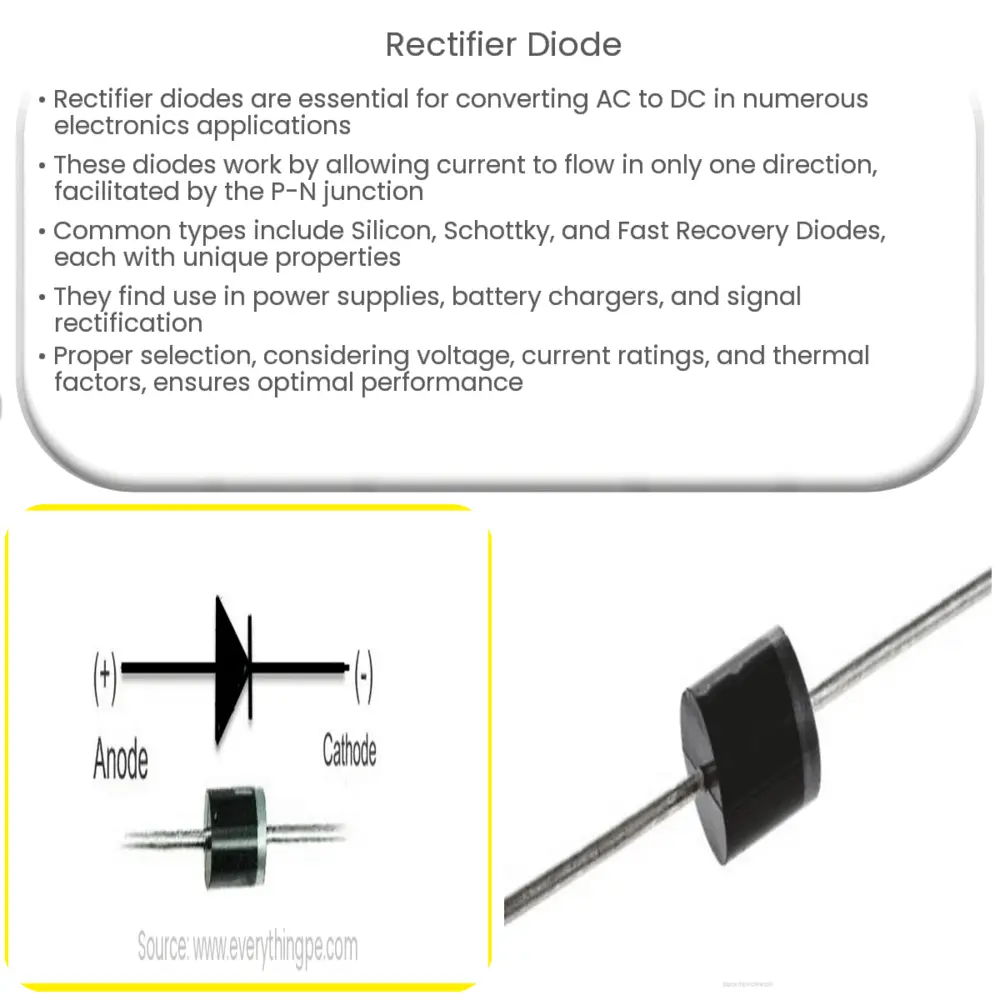A rectifier diode is a semiconductor device that converts alternating current (AC) to direct current (DC) by allowing current flow in one direction.

Understanding Rectifier Diodes: Principles and Applications
Introduction
A rectifier diode is a fundamental electronic component that plays a crucial role in converting alternating current (AC) to direct current (DC). This process, known as rectification, is vital in various applications, including power supplies, battery chargers, and electronic circuits. In this article, we will explore the principles behind rectifier diodes, their types, and common applications.
How Rectifier Diodes Work
At its core, a diode is a two-terminal semiconductor device that allows current to flow in only one direction. The diode comprises a P-type semiconductor, which has an excess of positive charge carriers (holes), and an N-type semiconductor, which has an excess of negative charge carriers (electrons). When these two materials are joined, the region where they meet is called the P-N junction.
Under forward bias conditions, when the P-type material is connected to the positive terminal of a voltage source and the N-type is connected to the negative terminal, the diode allows current to flow. Conversely, under reverse bias conditions, when the P-type is connected to the negative terminal and the N-type to the positive terminal, the diode blocks current flow. This unidirectional behavior is what enables diodes to convert AC to DC, as they can effectively block the negative half-cycle of the AC waveform.
Types of Rectifier Diodes
Rectifier diodes can be categorized based on their structure, voltage and current handling capabilities, and other properties. Some common types include:
- 1. Silicon Diodes: These are the most widely used rectifier diodes, offering a balance of performance, reliability, and cost-effectiveness. Silicon diodes have a forward voltage drop of approximately 0.7 volts.
- 2. Schottky Diodes: Schottky diodes have a metal-semiconductor junction instead of a P-N junction, resulting in a lower forward voltage drop (typically 0.2-0.3 volts) and faster switching speeds. They are often used in high-frequency applications and power supplies with low voltage output.
- 3. Fast Recovery Diodes: These diodes are designed to switch from conducting to blocking mode quickly, making them ideal for high-frequency applications where minimizing reverse recovery time is crucial. They are commonly used in switched-mode power supplies and inverter circuits.
Rectifier Diode Applications
Rectifier diodes are used in a wide range of applications, including:
- 1. Power Supplies: In both linear and switched-mode power supplies, rectifier diodes are used to convert AC input voltage to DC output voltage, which is then regulated and supplied to the load.
- 2. Battery Chargers: Diodes are essential in battery chargers for preventing reverse current flow, ensuring that the battery charges correctly and maintains its stored energy.
- 3. Signal Rectification: In communication systems, diodes can be used to extract the modulated signal from an AC carrier wave, enabling the recovery of the original information.
Half-Wave and Full-Wave Rectifiers
Rectifier circuits can be configured in two primary ways: half-wave rectification and full-wave rectification. Each configuration has its advantages and limitations.
- 1. Half-Wave Rectifiers: In a half-wave rectifier, only one half of the AC waveform is allowed to pass through the diode, while the other half is blocked. This results in a pulsating DC output, which may require further filtering to achieve a smoother output. Half-wave rectifiers are simple, cost-effective, and suitable for low-power applications.
- 2. Full-Wave Rectifiers: Full-wave rectifiers use multiple diodes or a combination of diodes and transformers to convert both the positive and negative half-cycles of the AC waveform into DC. This configuration provides a smoother output with less ripple, making it more suitable for high-power applications. However, full-wave rectifiers are more complex and can be less efficient than half-wave rectifiers.
Bridge Rectifiers
A popular full-wave rectifier configuration is the bridge rectifier. It consists of four diodes arranged in a bridge configuration, allowing both half-cycles of the AC waveform to be rectified. Bridge rectifiers are commonly used in power supplies and battery chargers due to their efficiency and the fact that they do not require a center-tapped transformer, which can be expensive and bulky.
Selection Considerations
When selecting a rectifier diode for a particular application, several factors should be taken into account:
- 1. Voltage Rating: The diode’s reverse voltage rating (also known as the peak inverse voltage or PIV) should be higher than the maximum voltage the diode will be subjected to in the application. This ensures that the diode will not break down or become damaged under normal operating conditions.
- 2. Current Rating: The diode’s forward current rating should be higher than the maximum current it will need to conduct in the application. This helps prevent overheating and premature failure.
- 3. Switching Speed: The diode’s reverse recovery time, which is the time it takes to switch from conducting to non-conducting state, should be considered for high-frequency applications. Faster switching speeds can result in lower power losses and improved efficiency.
- 4. Thermal Considerations: The diode’s power dissipation and thermal resistance should be considered to ensure proper heat management and avoid overheating or thermal runaway.
Conclusion
Rectifier diodes play a vital role in converting AC to DC in various electronic applications. Understanding the principles behind their operation, the different types of rectifier diodes, and their applications can help you make informed decisions when selecting and designing circuits. By considering factors such as voltage and current ratings, switching speed, and thermal management, you can optimize your rectifier diode selection and ensure reliable, efficient performance in your electronic projects.

